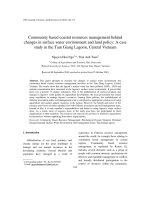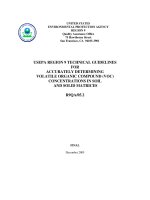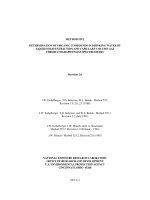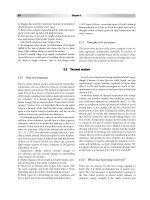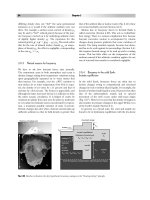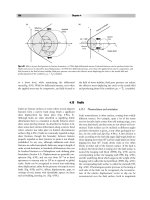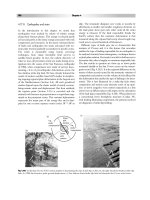Chemical Pollutants in Air, Water, Soil, and Solid Wastes Phần pps
Bạn đang xem bản rút gọn của tài liệu. Xem và tải ngay bản đầy đủ của tài liệu tại đây (838.72 KB, 10 trang )
Handbook of
Environmental
Analysis
Chemical P
ollutants in Air,
Water, Soil, and Solid Wastes
Pradyot Patnaik, Ph.D.
LEWIS PUBLISHERS
Boca Raton New York London Tok
y
o
ANALYTICAL
TECHNIQUES
1
© 1997 by CRC Press LLC
© 1997 by CRC Press LLC
2
PRECISION
AND ACCURACY OF ANALYSIS
QUALITY ASSURANCE AND QUALITY CONTR
OL
IN ENVIRONMENTAL ANALYSIS
Quality assurance and quality control programs mandate that e
very labora-
tory follow a set of well-defined guidelines so as to achieve analytical results at
a high degree of accuracy. The term quality assurance refers to a set of principles
that are defined, documented, and strictly observed such that the accuracy of
results of analysis may be stated with a high level of confidence and legally
defensible. The quality assurance plan includes documentation of sampling
events, receipt of samples in the laboratory, and their relinquish to respective
individuals to perform analysis; all of which are recorded on chain-of-custody
forms with dates and times, as well as the names and signatures of individuals
responsible to perform the tasks. The plan, in a broader sense of the term, also
includes quality control.
The laboratory quality control program has several components: documen-
tation of standard operating procedures for all analytical methods, periodic deter-
mination of method detection levels for the analytes, preparation of standard
calibration curves and daily check of calibration standards, analysis of reagent
blank, instrument performance check, determination of precision and accuracy
of analysis, and preparation of control charts. Determination of precision and
accuracy of analysis and method detection limits are described under separate
subheadings in the following sections. The other components of the quality
control plan are briefly discussed below.
The preparation of a standard calibration curve is required for many colori-
metric and gas chromatography analyses. A fresh calibration check standard at
any selected concentration should be prepared daily and analyzed prior to sample
analysis. If the response for the check standard falls outside of ± 15% standard
deviation for the same concentration in the standard calibration curve, then a new
calibration curve should be prepared.
1.2
© 1997 by CRC Press LLC
© 1997 by CRC Press LLC
16
AN
ALYSIS OF ORGANIC POLLUTANTS
BY GAS CHR
OMATOGRAPHY
Gas chromatograph
y (GC) is the most common analytical technique for the
quantitative determination of organic pollutants in aqueous and nonaqueous sam-
ples. In environmental analysis, a very low detection limit is required to determine
the pollutants at trace levels. Such low detection can be achieved by sample
concentration followed by cleanup of the extract to remove interfering substances.
Sample extractions and cleanup procedures are described in detail in Chapter 5
of Part 1 of this text.
Aqueous samples containing volatile organics can be directly analyzed by
GC (without any separate sample extraction steps) interfaced with a purge and
trap setup. The analytes in the sample are concentrated by the purge and trap
technique, (as discussed in the following section), prior to their analysis by GC
or GC/MS. The volatile organics in soils, sediments, and solid wastes may be
analyzed in a similar way by subjecting an aqueous extract of the sample to purge
and trap concentration. Alternatively, the analytes may be thermally desorbed
from the solid matrices and transported onto the GC column by a carrier gas.
At the outset, one must understand certain principles of GC to assess if it is
a proper analytical tool for the purpose. If so, how to achieve the best separation
and identification of component mixtures in the sample with reasonable precision,
accuracy, and speed? And what kind of detector and column should be selected
for the purpose? It is, therefore, important to examine the type of compounds
that are to be analyzed and certain physical and chemical properties of these
compounds. Information regarding the structure and the functional groups, ele
-
mental composition, the polarity in the molecule, its molecular weight, boiling
point, and thermal stability are very helpful for achieving the best analysis. After
we know these properties, it is very simple to perform the GC analysis of
component mixtures. To achieve this, just use an appropriate column and a proper
detector. Properties of columns and detectors are highlighted below in the fol-
lowing sections.
Efficiency of the chromatographic system can be determined from the number
of theoretical plates per meter. Although this term primarily describes the property
and resolution efficiency of a column, other extra column variables, such as the
1.3
© 1997 by CRC Press LLC
© 1997 by CRC Press LLC
AN
ALYSIS OF ORGANIC POLLUTANTS
BY GAS CHROMATOGRAPHY/
MASS SPECTR
OMETRY
Gas chromatograph
y/mass spectroscopy (GC/MS) is probably the best tech-
nique to identify a wide array of unknown organic substances in sample matrices.
It is also the most positive confirmatory test to determine the presence of pollut-
ants in the sample. Its application in environmental analysis has grown up enor-
mously in the last decade.
The method is based on the principle of chromatographic separation of
components of a mixture on a GC column, followed by their identification from
their mass spectra. The compounds are separated on a suitable GC column,
following which, the components eluted from the column are subjected to elec-
tron-impact or chemical ionization. The fragmented and molecular ions are iden-
tified from their characteristic mass spectra. Thus, the substances present in the
sample are determined from their characteristic primary and secondary ions and
also from their retention times.
For the analysis of organic pollutants in environmental samples, U.S. EPA
has classified them into two categories: volatile organics and semivolatile organics
(Figure 1.4.1). The substances in the former category are those that are more or
less volatile at ambient temperature and pressure. This classification, however, is
based on the analytical technique used rather than the chemical structures of
pollutants. For example, chloroform and
p
-xylene are very different in their
structures and chemical properties. The only property that groups them together
is that both are volatile substances. Although the volatile pollutants are expected
to have low boiling points, there are a few compounds such as ethylbenzene,
xylenes, or dichlorobenzenes that have boiling points higher than that of water.
V
OLATILE ORGANICS BY PURGE AND TRAP METHOD
T
wo techniques may be applied to transfer the volatile analytes from the sample
matrices onto the GC column: purge and trap technique and thermal desorption. In
the purge and trap method, an aliquot of aqueous sample (usually 5 mL for waste-
waters and 25 mL for drinking waters) is bubbled through by helium or nitrogen
for 11 min. The analytes are purged out from the sample and carried over with the
purging gas onto a trap consisting of activated charcoal, tenax, and silica gel
1.4
© 1997 by CRC Press LLC
© 1997 by CRC Press LLC
EXTRA
CTION OF ORGANIC POLLUTANTS
AND SAMPLE CLEANUP
SAMPLE EXTRACTION
Or
ganic pollutants in potable or nonpotable waters, soils, sediments, sludges,
solid wastes, and other matrices must be brought into an appropriate organic
solvent for their injection into the gas chromatography (GC) column. Such extrac-
tion also enables the increase the concentration of analytes in samples by several
order of magnitude for their detection at ppb or ppt level. Depending upon the
nature of sample matrices, various extraction techniques may be effectively
applied for accurate and low level detection of organics. These are outlined below
in the following schematic diagram.
Figure 1.5.1
Schematic diagram of various extraction techniques.
1.5
© 1997 by CRC Press LLC
© 1997 by CRC Press LLC
TITRIMETRIC
ANALYSIS
T
itration is one of the most commonly employed techniques in wet analysis.
Many routine analysis of wastewaters, potable waters, and aqueous extracts of
sludges and soils can be effectively performed using various titrimetric techniques.
In general, any titrimetric procedure involves slow addition of a solution of
accurately known concentraion (a standard solution) to a solution of unknown
concentration (sample to be analyzed) until the reaction between both the solutions
is complete. In other words, the standard titrant is added slowly up to the point
known as
end point
at which the solute analyte in the sample is completely con-
sumed by the solute in the standard solution. The completion of the reaction is
usually monitored by using an indictor, which causes a color change at the end point.
Titrimetric methods generally employed in environmental analysis may be
broadly classified into the following types:
1.
Acid-base titration
2. General redox titration
3. Iodometric titration
4. Argentometric titration
5. Complexometric titration
The abo
ve classification highlights the common analytical methods. There
is, however, a great deal of overlapping as far as the chemistry of the process is
involved. For example, iodometric method involves an oxidation-reduction reac-
tion between thiosulfate anion and iodine. It is, however, classified here under a
separate heading because of its wide application in environmental analysis.
Table 1.6.1 highlights some of the aggregate properties and parameters that
can be determined by various titrimetric methods.
ACID-BASE
TITRATION
Acid-base titration in
volves a neutralization reaction between an acid and a
soluble base. The reactants may be a strong acid and a strong base, a strong acid
1.6
© 1997 by CRC Press LLC
© 1997 by CRC Press LLC
